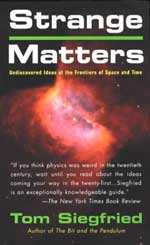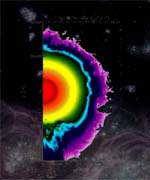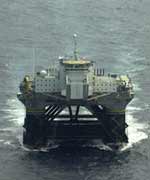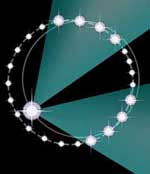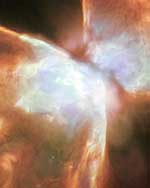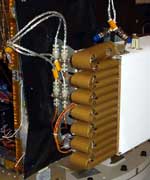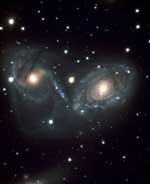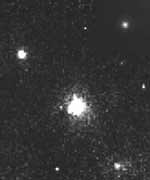
Image credit: Hubble
University of California scientists working at Los Alamos National Laboratory have proposed a new theory to explain the movement of vast energy fields in giant radio galaxies (GRGs). The theory could be the basis for a whole new understanding of the ways in which cosmic rays — and their signature radio waves — propagate and travel through intergalactic space.
In a paper published this month in The Astrophysical Journal Letters, the scientists explain how magnetic field reconnection may be responsible for the acceleration of relativistic electrons within large intergalactic volumes. That is, the movement of charged particles in space that are originally energized by massive black holes.
“If our understanding of this process is correct,” says Los Alamos astrophysicist Philipp Kronberg, “it could be a paradigm shift in current thinking about the nature of GRGs and cosmic rays.”
Researchers still do not fully understand why magnetic field reconnection occurs, but this much is known: a deeper understanding of the mechanism could have important applications here on Earth, such as the creation of a system of magnetic confinement for fusion energy reactors.
If the Los Alamos scientists’ theory is correct, the discovery also has wide-ranging astrophysical consequences. It implies that magnetic field reconnection or some other highly efficient field-to-particle energy conversion process could be a principal source of all extragalactic radio sources, and possibly also the mysterious “Ultra High Energy Cosmic Ray particles”.
Giant radio galaxies are vast celestial objects that emit a continuum of radio wavelengths detectable with radio telescopes like those at the Very Large Array in Socorro, N.M. Using comprehensive data on seven of the largest radio galaxies in the Universe gathered over the past two decades, the researchers were able to study cosmic ray energy fields that are expelled from the GRGs centers — which are almost certain to contain supermassive black holes — outward as much as a few millions of light years into intergalactic space (1 light year = 5,900,000,000,000 miles).
What the Los Alamos researchers concluded was that the high energy content of these giant radio galaxies, their large ordered magnetic field structures, the absence of strong large-scale shocks and very low internal gas densities point to a direct and efficient conversion of the magnetic field to particle energy in a process that astrophysicists call magnetic field reconnection. Magnetic field reconnection is a process where the lines of a magnetic field connect and vanish, converting the field’s energy into particle energy. Reconnection is considered a key process in the sun’s corona for the production of solar flares and in fusion experiment devices called tokamaks. It also occurs in the interaction between the solar wind and the Earth’s magnetic field and is considered a principal cause of magnetospheric storms.
The research determined that the measurement of the total energy content of at least one of these giant radio galaxies — which is believed to have at its center a black hole with a mass equal to 100 million times that of our sun — was 10 61 ergs. Ergs are a measure of energy where one erg is the amount of energy needed to lift one gram of weight a distance of one centimeter. This energy level of 10 61 ergs is several times more than the thermonuclear energy that could be released by all the stars in a galaxy, offering substantial proof to the researchers that the source of the measured energy could not be typical solar fusion or even supernovae.
In addition to the high energy content, the large, orderly structure of the magnetic field and the absence of strong large-scale shocks — like those that might be present from a supernova explosion — led the scientists to believe that the process of magnetic field reconnection is at work.
In addition to Kronberg, the theory is the result of work by Los Alamos scientists Stirling Colgate, Hui Li and Quentin Dufton. The research was funded by Los Alamos Laboratory-Directed Research and Development (LDRD) funding. LDRD funds basic and applied research and development focusing on creative concepts selected at the discretion of the Laboratory Director.
Los Alamos National Laboratory is operated by the University of California for the National Nuclear Security Administration (NNSA) of the U.S. Department of Energy and works in partnership with NNSA’s Sandia and Lawrence Livermore national laboratories to support NNSA in its mission.
Los Alamos enhances global security by ensuring safety and confidence in the U.S. nuclear stockpile, developing technologies to reduce threats from weapons of mass destruction and improving the environmental and nuclear materials legacy of the cold war. Los Alamos’ capabilities assist the nation in addressing energy, environment, infrastructure and biological security problems.
Original Source: Los Alamos National Laboratory News Release

